Part of our “Geared Up for Transcription” Series
A transcriptionist knows that little things matter. The right tool can make all the difference. In a previous blog, we talked about keyboards and the importance of choosing the right one. So you might have the latest and greatest in ergonomic keyboards, but you may be surprised to learn that it’s only half the battle. Today, we are going to look underneath your keyboard and ask, what is your keyboard sitting on…and why does it matter?
For those who don’t do a high volume of typing, a keyboard tray (often a keyboard drawer) is a convenient way to hide their keyboard and buy back some precious desktop real estate. But as a transcriptionist, you probably work at home and spend many hours typing. Your keyboard platform is critical to your comfort and thus critical to your speed and efficiency.
Why does the keyboard tray matter? There are three main reasons.
1) Arm position: Are your arms too high or too low?
If your arms are too high, you are unconsciously contracting muscles to keep them elevated to the height of the keyboard. This puts you at greater risk for fatigue or repetitive motion injury. If your arms are too low, you may be in an uncomfortable position for typing, but this can also cause you to hunch over the keyboard, which can adversely affect your neck and back.
2) Distance from the keyboard: Are you reaching too far to type?
If your keyboard is too far away, you may be leaning forward to type, which will reduce the support for your lower back. If your keyboard is too close, you may be causing tension and risking fatigue by pulling back with your upper arms.
3) Mouse platform: Are you bending or reaching for your mouse?
If you are bending at the middle to reach for your mouse, or lifting/extending your arms repeatedly, you are, again, increasing the chance of fatigue and/or injury. Your mouse should be within easy reach without too much arm or body motion.
So, what is the ideal position for typing?
According to Medicinenet.com, the ideal position to reduce risk of fatigue and repetitive motion ailments is as follows:
- Upper arm position: Your shoulders should be relaxed with your upper arms at rest and perpendicular to the floor. This prevents fatigue by ensuring that you are the proper distance from your keyboard.
- Forearm position: Your forearms should be parallel to the floor. This will ensure that the height of the keyboard is correct.
- Wrist position: You should not be bending your wrists more than a few degrees. This will indicate the proper angle for your keyboard.
In addition to the above, your mouse platform should be within easy reach, ideally in the same plane as your keyboard, and not too far to the left or right. Keep in mind that these are guidelines and everyone is different, so you need to position your keyboard in a way that is comfortable for you. But in any case, position matters!
How do you get a perfect position?
The answer to all of the above is to have a keyboard that can be easily repositioned, and that usually requires a tray that you can adjust and reposition freely.
Here are five trays that have the proper features to make them adjustable to a good typing position for transcription. To make our recommendations, we looked for a good combination of features and value for home office use.
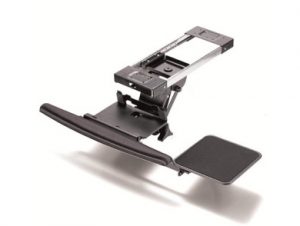 1. Cotytech Fully Adjustable Ergonomic Keyboard Mouse Tray: About $98
1. Cotytech Fully Adjustable Ergonomic Keyboard Mouse Tray: About $98
The Cotytech offers a good blend of reasonable price and solid features, including a height adjustment range among the highest in the category. That makes it a good bet for value-minded transcriptionists.
Key features:
• 5.9 inches of height adjustment
• Left/right-hand mouse tray
• Wrist rest
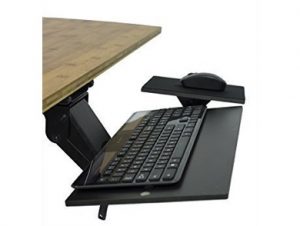 2. Uncaged Ergonomics Ergonomic Under Desk Keyboard Tray: About $80
2. Uncaged Ergonomics Ergonomic Under Desk Keyboard Tray: About $80
This Uncaged Ergonomics Keyboard is a good value and is feature rich, including an independently adjustable mouse pad that connects to the right or left side of the keyboard.
Features:
• 4.5 inches of inches of height adjustment
• Adjustable keyboard angle that includes negative tilt
• Swiveling tray
• Left/right-hand mouse tray with independent adjustment
3. 3M Adjustable Desktop Keyboard Drawer: About $160
This 3M keyboard tray sits on top of your desk, so there is no installation needed. It’s a novel approach, which is good if you don’t want to drill holes in the bottom of your desk…but a bit on the pricey side.
Features:
• No mounting – place right on your desk
• 3.25 inches of height adjustment below desk (unit sits on top of your desk)
• Includes lifetime warranty
4. Fellowes Adjustable Keyboard Tray: About $60
The Fellowes Adjustable Tray is the value purchase in our lineup. It is height and tilt adjustable via a single knob with rotating tray, and a gel wrist rest.
Features:
• Gel-filled wrist rest
• Swiveling tray
• Left/right-hand mouse tray
5. Mount-It! MI-7134 Underdesk Keyboard Drawer with Adjustable Platform: About $147
The MountIt! tray has the highest amount of height and tilt adjustment in the group, so it is the most flexible. It includes a gel wrist pad, swiveling tray, and mouse surface.
Features:
• 5.9 inches of height adjustment
• Keyboard tilt from +25 to -40 degrees
• Swiveling, left/right-hand mouse tray
• Wrist rest
Do you have a keyboard/tray set up at your home office that you like? Let us know!


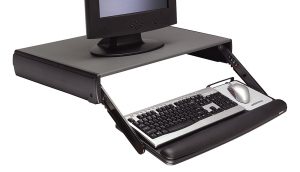
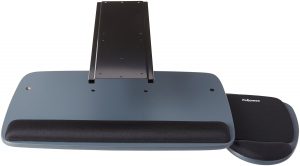
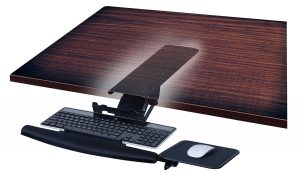
Great recommendations! It has been too many years since I have cobbled together a separate wrong-sized keyboard tray, typing wrist rest and mouse wrist rest. Time to spend some hard-earned cash on my own wellness and ergonomics so that I can keep working in the best of health.
Thank you.
It is on the pricey side of things, but it is awesome. It has 180 degrees of swivel and a range of height that is awesome. I love this tray.
https://www.kensington.com/us/us/4474/k60719us/kensington-long-neck-modular-platform-with-smartfit-system
Thanks for this blog providing insights regarding different aspects to be considered while choosing the right keyboard tray. We often tend to ignore little things as we select gadgets and their accessories. I am sure this blog is going to help many make the right choice. Great blog indeed. http://innofitt.com/